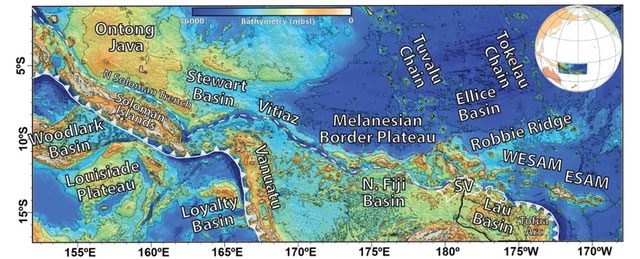Along the northeastern edge of the Pacific Ocean lies a vast underwater plateau nearly the size of the United Kingdom, often referred to as the “graveyard” of dead coral reefs and failed islands.
The research led by geologist Kevin Konrad from the University of Nevada (USA) has uncovered the complex origins of the Melanesian Border Plateau (MBP), a “fire plateau” that spans an area of up to 222,000 km2 beneath the Pacific.

MBP fire plateau reveals a significant process in the geological development of the planet – (Photo: UNIVERSITY OF NEVADA).
For a long time, volcanic structures like the MBP were believed to have formed from a single catastrophic volcanic event.
However, recent research indicates a much more complex history, which may help humanity better understand how the Earth was formed.
According to Science Alert, the excavation of material from the “fire plateau” shows that it possesses a part of its “rocky skeleton” composed of cooled magma released approximately 122-83 million years ago, a period during the Cretaceous.
Further analysis revealed that there are a total of 25 distinct volcanic structures responsible for its entire history.
The first event in the Cretaceous was caused by a mantle plume in the South Pacific known as the Louisville hotspot. A mantle plume is an upwelling of an unusually hot rock mass within the Earth.
About 45 million years later, the Rurutu-Arago hotspot emerged, witnessing the rise of new islands and seamounts. Time will eventually pull them into the depths, but their roots have contributed to the structural foundation of the plateau.
The third hotspot, responsible for today’s Samoa Islands, reactivated the formation of seamounts, islands, and a new wave of volcanic activity around 20 million years ago.
The Samoa hotspot remains active today, creating new islands.
Additionally, the deformation of the Earth’s crust due to tectonic activity continues to reshape the fire plateau. This means that the plateau will continue to change and evolve in the future.
These findings, recently published in the journal Earth and Planetary Science Letters, provide a more detailed picture of how massive underwater structures are formed, showing just how complex the features beneath the ocean can be.
Moreover, geological activity is one of the critical factors that make our world hospitable to life.
Gaining a deeper understanding of how its intricate structures are formed is essential for scientists to learn what we need to create a planet as friendly and rich as Earth.


















































